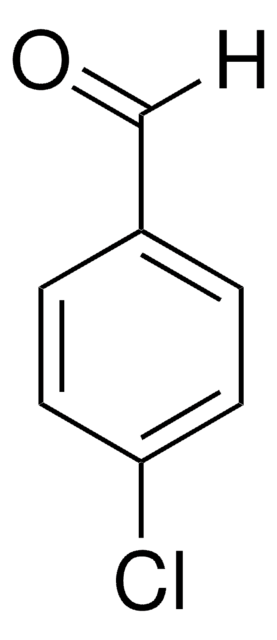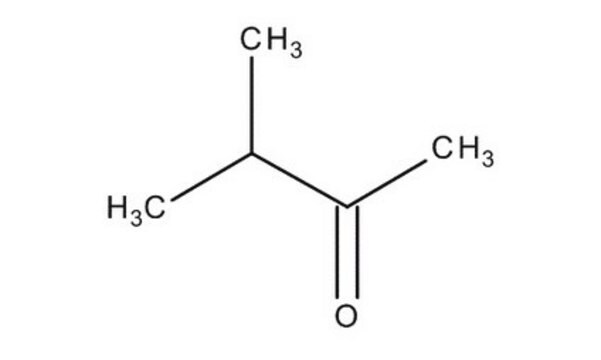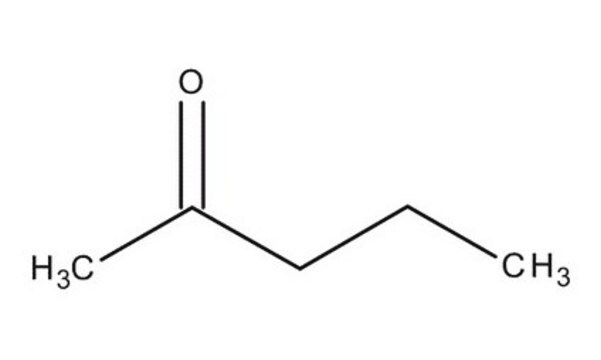8.03605
Diethyl ketone
for synthesis
Synonym(s):
Diethyl ketone, 3-Pentanone, Ethyl ketone
About This Item
synthesis grade
Recommended Products
grade
for synthesis
synthesis grade
Quality Level
vapor pressure
37.6 hPa ( 20 °C)
Assay
≥99% (GC)
form
liquid
autoignition temp.
425 °C
potency
2900 mg/kg LD50, oral (Rat)
16200 mg/kg LD50, skin (Rabbit)
expl. lim.
1.6-7.7 % (v/v)
dilution
(for synthesis)
pH
6.2 (20 °C, 50 g/L in H2O)
bp
101-103 °C/1013 mbar
mp
-40 °C
transition temp
flash point 7 °C
solubility
50 g/L
density
0.81 g/cm3 at 20 °C
storage temp.
2-30°C
SMILES string
O=C(CC)CC
InChI
1S/C5H10O/c1-3-5(6)4-2/h3-4H2,1-2H3
InChI key
FDPIMTJIUBPUKL-UHFFFAOYSA-N
Application
- Resonance Stabilization Effects on Ketone Autoxidation: Isomer-Specific Cyclic Ether and Ketohydroperoxide Formation in the Low-Temperature (400-625 K) Oxidation of Diethyl Ketone.: This study examines the low-temperature oxidation of diethyl ketone, highlighting how resonance stabilization influences the formation of specific cyclic ethers and ketohydroperoxides, vital for understanding combustion mechanisms and environmental implications of ketone use in industrial applications (Scheer AM et al., 2016).
- Low-temperature combustion chemistry of novel biofuels: resonance-stabilized QOOH in the oxidation of diethyl ketone.: This research focuses on the combustion chemistry of diethyl ketone as a biofuel, providing insights into the formation of resonance-stabilized QOOH intermediates which are crucial for developing more efficient and cleaner burning fuels (Scheer AM et al., 2014).
- Wet effluent diffusion denuder technique and determination of volatile organic compounds in air. I. Oxo compounds (alcohols and ketones).: Explores the use of diethyl ketone in air quality monitoring, employing a novel wet effluent diffusion denuder technique for the sensitive detection of oxo compounds, vital for environmental monitoring and regulatory compliance (Pesková J et al., 2001).
- Identification limits for volatile organic compounds in the blood by purge-and-trap GC-FTIR.: Discusses the detection limits of volatile organic compounds, including diethyl ketone, in blood using advanced purge-and-trap gas chromatography coupled with Fourier-transform infrared spectroscopy, emphasizing its importance in forensic and toxicological analyses (Ojanperä I et al., 1998).
Analysis Note
Density (d 20 °C/ 4 °C): 0.813 - 0.815
Identity (IR): passes test
Signal Word
Danger
Hazard Statements
Precautionary Statements
Hazard Classifications
Eye Irrit. 2 - Flam. Liq. 2
Supplementary Hazards
Storage Class Code
3 - Flammable liquids
WGK
WGK 1
Flash Point(F)
44.6 °F
Flash Point(C)
7 °C
Regulatory Listings
Regulatory Listings are mainly provided for chemical products. Only limited information can be provided here for non-chemical products. No entry means none of the components are listed. It is the user’s obligation to ensure the safe and legal use of the product.
FSL
Flammable liquids
Type 1 petroleums
Hazardous rank II
Water insoluble liquid
ISHL Indicated Name
Substances Subject to be Indicated Names
ISHL Notified Names
Substances Subject to be Notified Names
Certificates of Analysis (COA)
Search for Certificates of Analysis (COA) by entering the products Lot/Batch Number. Lot and Batch Numbers can be found on a product’s label following the words ‘Lot’ or ‘Batch’.
Already Own This Product?
Find documentation for the products that you have recently purchased in the Document Library.
Customers Also Viewed
Our team of scientists has experience in all areas of research including Life Science, Material Science, Chemical Synthesis, Chromatography, Analytical and many others.
Contact Technical Service










